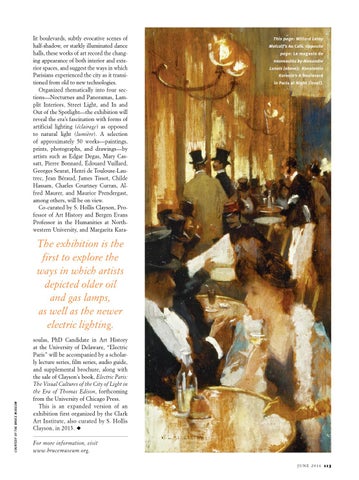lit boulevards, subtly evocative scenes of half-shadow, or starkly illuminated dance halls, these works of art record the changing appearance of both interior and exterior spaces, and suggest the ways in which Parisians experienced the city as it transitioned from old to new technologies. Organized thematically into four sections––Nocturnes and Panoramas, Lamplit Interiors, Street Light, and In and Out of the Spotlight––the exhibition will reveal the era’s fascination with forms of artificial lighting (éclairage) as opposed to natural light (lumière). A selection of approximately 50 works––paintings, prints, photographs, and drawings––by artists such as Edgar Degas, Mary Cassatt, Pierre Bonnard, Édouard Vuillard, Georges Seurat, Henri de Toulouse-Lautrec, Jean Béraud, James Tissot, Childe Hassam, Charles Courtney Curran, Alfred Maurer, and Maurice Prendergast, among others, will be on view. Co-curated by S. Hollis Clayson, Professor of Art History and Bergen Evans Professor in the Humanities at Northwestern University, and Margarita Kara-
This page: Willard Leroy Metcalf’s Au Café. Opposite page: Le magasin de nouveautés by Alexandre Lunois (above); Konstantin Korovin’s A Boulevard in Paris at Night (inset).
CO U RTE S Y O F T H E B RU C E M U S E U M
The exhibition is the first to explore the ways in which artists depicted older oil and gas lamps, as well as the newer electric lighting. soulas, PhD Candidate in Art History at the University of Delaware, “Electric Paris” will be accompanied by a scholarly lecture series, film series, audio guide, and supplemental brochure, along with the sale of Clayson’s book, Electric Paris: The Visual Cultures of the City of Light in the Era of Thomas Edison, forthcoming from the University of Chicago Press. This is an expanded version of an exhibition first organized by the Clark Art Institute, also curated by S. Hollis Clayson, in 2013. u For more information, visit www.brucemuseum.org. JUNE 2016 113
